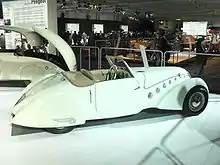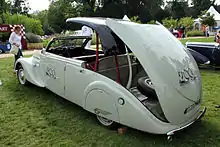Georges Paulin
Georges Paulin was a dentist, noted automobile designer and hero of the French Resistance during the Second World War.


Born 1902 in a working class section of Paris, Paulin would later design the 1935 Peugeot 601 C Eclipse, the first production retractable hardtop convertible.
Auto designer
Between 1934 and 1938, he was the designer for French coachbuilder Marcel Pourtout. Among his designs were a Panhard coupe, a Unic cabriolet, a Delage D8, the "water drop" Talbot-Lago, the Darl'mat Peugeot roadsters used in 1937 and 1938 at Le Mans.
Richard Adatto, author of a book on French aerodynamic styling of the era,[1] said
- "Paulin became the leading French stylist of the time...Everything he touched was designed with aerodynamics in mind. He was very conscious of fuel efficiencies and the aerodynamic efficiencies that could be created by the lines of the car. You could go faster, which meant you could put a smaller engine in the car and it could go faster even though it was a small car."[2]
Pourtout, Emile Darl'mat, and Paulin collaborated in the creation of the revolutionary Eclipse roof, the first power-operated retractable hardtop, which was patented by Paulin in 1931 and in 1934 was used in the Peugeot 402BL Éclipse Décapotable, a small coupe.[3] Carrosserie Pourtout produced Eclipse versions of the Peugeot 301, 401, 402 and 601, the Lancia Belna, and models from Hotchkiss and Panhard.
From 1938 to 1939, he worked exclusively for Rolls-Royce-Bentley. For them he designed the Corniche 1 in 1939 and the Comet Competition.
Additionally, he designed one of the most significant pre-war Derby Bentleys, the Embiricos Bentley B27LE, built again by Pourtout. This car departed from standard Bentley practice, by not using the standard Bentley grille, in favor of hiding it behind a streamlined grille. Amazingly this car was entered in the 1949 Le Mans 24 heures du Mans where it finished 6th overall and entered the two subsequent races finishing 14th and 22nd, with over 120,000 miles on the odometer.
From an automobile, purchased in 1993, and initially restored as a 100 point chassis, Gary Moore from California created a roadster, based upon Paulin's design, B25GP which hopefully will be displayed next to its predecessor at Pebble in 2019 - Bentley's centennial. This automobile took over 14 years to complete with some of California's master craftsman weighing in with buck fabrication, metalwork, chrome and interior finishing.
World War II resistance
In July 1940, while he was an engineer at Avions Kellner-Béchereau, Georges Paulin began working with British Intelligence to fight the Nazis. Discovered by the Gestapo thanks to French Vichy elements he was arrested in 1941 and condemned to death by a German military tribunal. He was executed March 1942. An escape plan had been arranged by the British, but Paulin declined to use it, and sacrificed himself in order to protect his team.[4]
He was posthumously awarded the Croix de Guerre and the Médaille de la Résistance by the French government.
References
- Adatto, Richard S, 2003. From Passion to Perfection: The Story of French Streamlined Styling 1930 - 1939 Archived 2011-10-12 at the Wayback Machine, SPE Barthélémy, ISBN 2-912838-22-3, reviewed at Auto History Online. Retrieved on July 2, 2008.
- Buchanan, James. "The Story of Lancia, Paulin and John Moir", redroom.com Archived 2011-07-26 at the Wayback Machine. Retrieved on July 2, 2008.
- "New Again: The Hideaway Hardtop". The New York Times, Rob Sass. December 10, 2006. Retrieved May 3, 2010.
- Classic & Sports Car magazine, January 2013; article on Embiricos Bentley, pp. 100–105. Author: Mick Walsh
External links
- The Kellner Affair: Matters of Life and Death by Peter M. Larsen and Ben Erickson. Details Jacques Kellner and George Paulin involvement in the French Resistance.
- Photographs of a 1938 Peugeot 402 Éclipse Décapotable
- Designed for Rolls Royce, the Corniche on the Bentley MK V chassis
